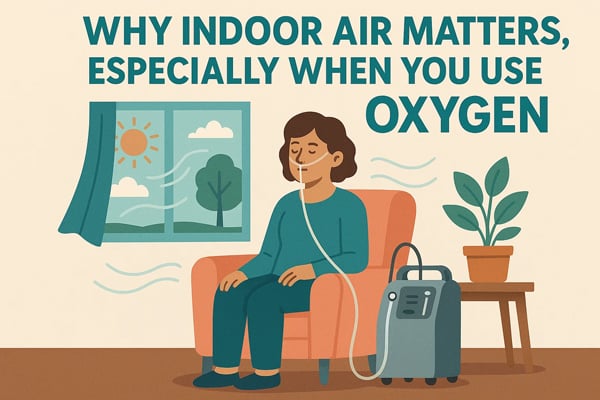
For millions of Americans with chronic respiratory conditions like COPD, pulmonary fibrosis, or emphysema, home is a haven. It’s a place to breathe, rest, and recover. But what if the air inside your home isn’t as clean as it seems?
Many people see outdoor air pollution as the main risk to their lungs. But studies show indoor air can be up to five times more polluted. Dust, mold, pet dander, chemical fumes, and cooking byproducts can accumulate indoors, particularly in tightly sealed, energy-efficient homes.
If you use supplemental oxygen, poor indoor air quality can be more than uncomfortable. It can directly impact your therapy, safety, and long-term lung health.
At LPT Medical, we specialize in oxygen therapy equipment and recognize the importance of clean indoor air for optimal breathing. Let’s look at why indoor air quality matters when you use oxygen and what you can do to make your home safer and healthier.
How Indoor Air Quality Affects Your Lung Health
Whether you use oxygen continuously or only as needed, your lungs are already working harder than most people’s. When the air inside your home contains pollutants, it adds an extra burden.
Common indoor air irritants include:
- Dust and dust mites – These microscopic particles can inflame the airways and trigger coughing or shortness of breath.
- Mold spores – Thrive in damp environments like bathrooms or basements and can worsen respiratory conditions.
- Pet dander – Small protein particles that can cause allergic reactions or airway irritation.
- Volatile organic compounds (VOCs) – Chemicals released from cleaning products, air fresheners, paints, and furniture.
- Combustion byproducts – Smoke from candles, wood-burning stoves, or even cooking can release tiny particles harmful to the lungs.
If you’re on oxygen therapy, these irritants can not only worsen breathing symptoms but also make your oxygen therapy less effective by reducing the quality of air your concentrator or tubing pulls in.
How Poor Indoor Air Quality Impacts Oxygen Therapy
Your oxygen concentrator draws in the air around it, filters out nitrogen, and provides a steady stream of oxygen-rich air. But it can only use the air in your home.
If your home’s air has smoke, chemicals, or fine dust, your device’s filters can clog more quickly. This means your therapy air might have unwanted impurities.
Here’s how poor air quality can affect your oxygen system:
1. Clogged or dirty filters
Dusty or smoky air makes your concentrator work harder. Over time, filters can clog, which reduces oxygen flow and concentration. This can cause your machine to overheat or give you lower-quality oxygen.
2. Reduced oxygen purity
If your oxygen concentrator takes in polluted air, its filters and sieve beds have to work harder to remove contaminants. Over time, this can lower the purity of the oxygen or wear out parts more quickly, even though the machine is designed to clean the air effectively.
3. Increased fire risk
Oxygen isn’t flammable, but it helps things burn. When it mixes with indoor pollutants like aerosol sprays, cooking grease, or cigarette smoke, your home can become a serious fire risk.
4. Aggravated respiratory symptoms
Poor indoor air quality can irritate your airways, increase mucus production, and exacerbate conditions like COPD or asthma. You should use your oxygen more often or at higher flow rates if your lungs are exposed to these irritants.

Why Oxygen Users Need to Be Especially Careful
If you’re using oxygen, you already know how critical every breath is. Because your lungs are more sensitive, even low levels of indoor pollutants can have a more pronounced effect.
Some key reasons oxygen users should pay extra attention to indoor air quality include:
- Reduced natural defense mechanisms: Lung diseases often impair the cilia (tiny hairs) that help filter particles from the airway.
- Increased oxygen exposure: The enriched oxygen you breathe and store in your tubing or cannula can make irritants or fumes feel stronger.
- Dependence on clean airflow: Since your device relies on room air, your oxygen therapy’s efficiency depends directly on your indoor air cleanliness.
- Medication sensitivity: Some medications used for COPD or pulmonary fibrosis can make airways more reactive to pollutants or scents.
Simply put, clean indoor air isn’t a luxury when you use oxygen. It’s an important part of your therapy plan.
Practical Steps to Improve Indoor Air Quality
You don’t need to overhaul your entire home to make a big difference. Start with these proven, practical steps:
1. Keep your oxygen device clean
Clean your oxygen concentrator’s vents often, replace filters on time, and wipe down surfaces. This helps keep dust and debris out of your airflow. Follow your manufacturer’s maintenance tips or ask LPT Medical for help.
2. Avoid smoking or open flames indoors
Never smoke near oxygen. Candles, fireplaces, and incense can also release particles and fumes that stick to surfaces and increase fire risk. Set up a smoke-free area for your oxygen use.
3. Use air purifiers with HEPA filters
A good HEPA air purifier can capture fine particles such as pollen, dust, and pet dander. Put one in the room where you use your oxygen concentrator most. Make sure the purifier blows clean air away from your device’s intake vent.
4. Control humidity
Keep humidity between 30% and 50%. If the air is too dry, your airways may feel irritated. If it’s too damp, mold can grow. Use a humidifier or dehumidifier as needed, and keep water reservoirs clean to prevent bacteria.
5. Choose cleaning products wisely
Avoid using harsh chemicals, aerosols, or scented sprays. Choose unscented, natural cleaners or diluted vinegar solutions instead. Never spray cleaners near your oxygen machine or tubing.
6. Ventilate regularly
Even in cold weather, open windows for 5 to 10 minutes each day to help clear out indoor air pollutants. Use exhaust fans when cooking or showering to reduce steam and fumes.
7. Schedule HVAC maintenance
Have your heating and cooling systems serviced regularly and replace air filters every 1–3 months. Consider upgrading to high-efficiency filters designed to capture fine particulates.
8. Watch out for hidden pollutants
Gas stoves, carpets, and furniture can release VOCs over time. Using range hoods, sealing wood furniture, or choosing low-VOC paints can help improve air quality.
Signs Your Indoor Air Quality May Be Affecting You
If you’re unsure whether your air is affecting your breathing, watch for these common warning signs:
- Increased coughing or wheezing indoors
- Burning eyes, sore throat, or nasal irritation
- Headaches that improve when you go outside
- Noticeable dust buildup on furniture or vents
- A musty or chemical odor in your home
- Needing higher oxygen flow rates more often
If you notice these symptoms, check your air quality, clean your filters, and consider using air purifiers.

How LPT Medical Helps You Breathe Easier
At LPT Medical, we know that safe, effective oxygen therapy depends on more than just the device. It also depends on the air you breathe.
That’s why we:
- Educate our customers on safe oxygen use and best practices for maintaining air quality.
- Carry only FDA-cleared oxygen concentrators, designed for consistent, clean delivery.
- Provide maintenance guidance to ensure your machine stays efficient and reliable.
- Offer accessories that help keep your setup hygienic and safe.
We care about every part of your respiratory health —not just your oxygen supply, but also the air you breathe every day.
Final Thoughts: Clean Air is Part of Your Therapy
For oxygen users, indoor air quality is not something to overlook. It is an essential part of effective treatment. Every breath you take should help you heal, not make breathing harder.
By taking simple steps to reduce pollutants, maintaining your equipment, and keeping your air fresh, you can protect your lungs, extend your equipment's life, and get the most out of your oxygen therapy.
At LPT Medical, we are here to help you breathe easier at home, at work, and wherever you go. If you have questions about safe oxygen use, concentrator maintenance, or improving your indoor air quality, our team is always ready to help.
Call us 800-946-1201


.png)



